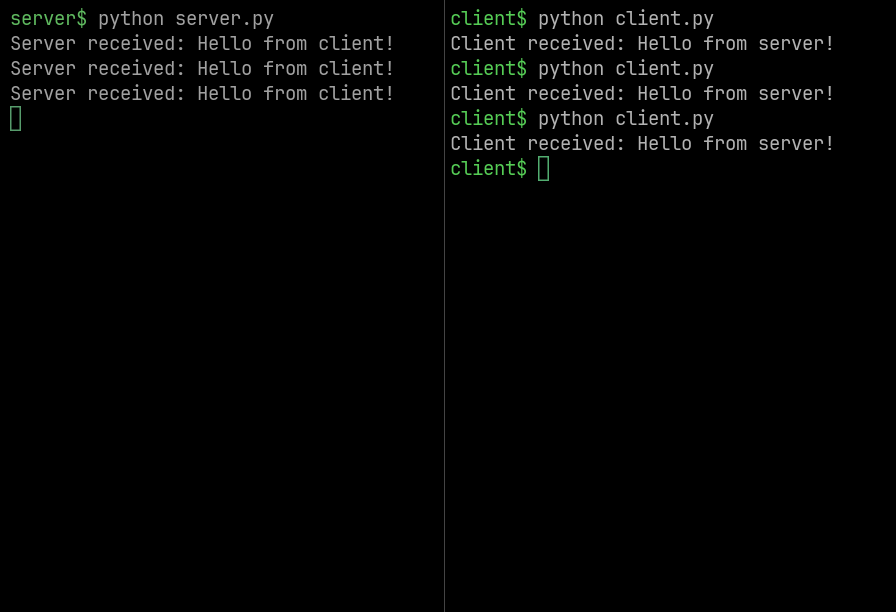Hello, aioquic! (QUIC implementation with Python)

Overview
This project demonstrates a simple implementation of a QUIC client and server
using the aioquic library in Python. The server listens for incoming QUIC
connections and echoes back messages received from the client. The client
connects to the server, sends a message, and prints the response.
Go version: Hello, quic-go! (QUIC implementation with Go)
Feature Highlights
- QUIC Protocol: Utilizes the QUIC protocol for low-latency, multiplexed connections.
- Asynchronous I/O: Built with
asynciofor efficient handling of multiple connections. - TLS Encryption: Uses TLS for secure communication between client and server.
- Self-signed Certificates: Generates self-signed certificates for local testing.
Screenshots

Use Cases
- Learning: Understand the basics of QUIC and how to implement it in Python.
- Prototyping: Quickly prototype applications that require low-latency communication.
- Testing: Test QUIC-based applications in a local environment.
Technologies Used
- Python: The programming language used to build the application.
- aioquic: A Python library for QUIC and HTTP/3.
- asyncio: Python's built-in library for writing concurrent code using the async/await syntax.
- OpenSSL: A robust, full-featured open-source toolkit for SSL and TLS.
Environment Setup
Install Dependencies
A Python virtual environment and OpenSSL are required to be installed.
The following command is for Ubuntu and Debian-based distributions. For any other OS or Linux distribution, check the relevant documentation.
sudo apt install python3-venv openssl
Create Project Directory
mkdir quic-python
cd quic-python
Create and Activate Python Virtual Environment
python -m venv venv
source venv/bin/activate
Create Requirements File
Create a file named requirements.txt with the following content:
aioquic==1.2.0
attrs==25.3.0
certifi==2025.8.3
cryptography==45.0.6
pyasn1==0.6.1
pyasn1_modules==0.4.2
pycparser==2.22
pylsqpack==0.3.22
pyOpenSSL==25.1.0
service-identity==24.2.0
typing_extensions==4.14.1
Install Python Dependencies
pip install -r requirements.txt
Generate Self-Signed Certificate for Localhost
This certificate is for local testing purposes only. For production use, a trusted Certificate Authority (CA) should be used.
openssl req \
-new \
-newkey rsa:2048 \
-days 365 \
-nodes \
-x509 \
-keyout key.pem \
-out cert.pem \
-subj "/CN=localhost" \
-addext "subjectAltName=DNS:localhost"
Code
Create Server
Create a server file server.py with the following content:
import asyncio
from aioquic.asyncio import QuicConnectionProtocol, serve
from aioquic.quic.configuration import QuicConfiguration
# Define server protocol (how to handle messages)
class ServerProtocol(QuicConnectionProtocol):
def quic_event_received(self, event):
if hasattr(event, "data"): # If data is received
print("Server received:", event.data.decode())
# Echo back to client
self._quic.send_stream_data(event.stream_id, b"Hello from server!")
# Run the QUIC server
async def main():
config = QuicConfiguration(is_client=False)
config.load_cert_chain("cert.pem", "key.pem") # TLS cert required
# Listen on localhost:4433
await serve("localhost", 4433, configuration=config, create_protocol=ServerProtocol)
await asyncio.get_running_loop().create_future() # Keep server running
if __name__ == "__main__":
asyncio.run(main())
Create Client
Create a client file client.py with the following content:
import asyncio
from aioquic.asyncio import connect, QuicConnectionProtocol
from aioquic.quic.configuration import QuicConfiguration
from aioquic.quic.events import StreamDataReceived
class ClientProtocol(QuicConnectionProtocol):
def quic_event_received(self, event):
if isinstance(event, StreamDataReceived):
print("Client received:", event.data.decode())
async def main():
config = QuicConfiguration(is_client=True)
config.verify_mode = False # disable TLS verification for local testing
config.load_verify_locations("cert.pem")
# Connect to server
async with connect(
"localhost", 4433, configuration=config, create_protocol=ClientProtocol
) as client:
stream_id = client._quic.get_next_available_stream_id()
client._quic.send_stream_data(stream_id, b"Hello from client!")
# Keep running for a bit to receive server reply
await asyncio.sleep(2)
if __name__ == "__main__":
asyncio.run(main())
Directory Structure
After creating the above files, project directory structure should look like this:
quic-python/
├── venv/
├── cert.pem
├── client.py
├── key.pem
├── requirements.txt
└── server.py
Running the Application
Run Server
Open a terminal, go to the project directory, activate the Python virtual environment, and then run the following command:
python server.py
Run Client
Open another terminal, go to the same directory, activate the Python virtual environment, and then run the following command:
python client.py